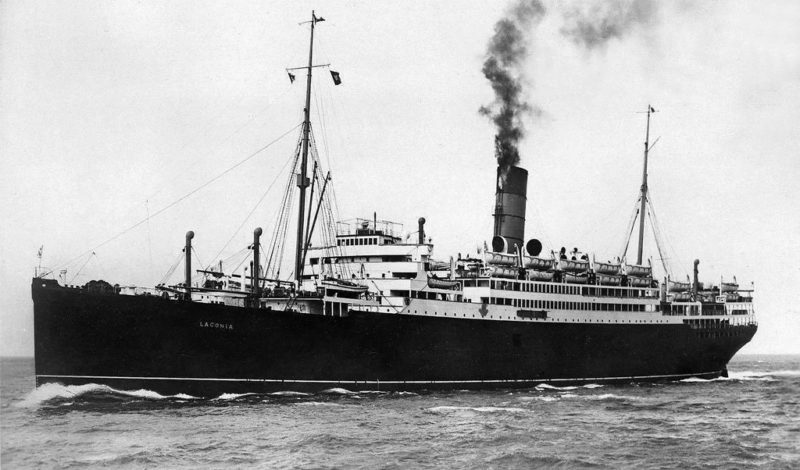
Laconia (Lakonia) is located on the south eastern part of Peloponnese peninsula of mainland Greece. It is bordered by Messenia to the west and Arcadia to the north.
It was also the name chosen for two Cunard passenger liners, one completed at the end of 1911, the loss of which would hasten the entry of the USA into the First World War. The second, completed just over ten years later, would change the orders for German U-boats in relation to the rescue of survivors from torpedoed ships and add to the evidence against alleged atrocities at the Nuremburg War Trials in 1946.
Laconia (Yard No 877) and her sister Franconia (Yard No 857) completed their maiden voyages in 1912 and 1911 respectively for Cunard Line’s Liverpool to New York/Boston service. The two liners appeared in the 1914 edition of Jane’s Fighting Ships as vessels capable of 18 knots and suitable for use as Armed Merchant Cruisers.
Both ships were just over 18,000 gross tons with a length of 625 feet a beam of 71 feet and a draught of 40 feet 6 inches. Two quad. 4–Cylinder steam engines driving two screws with an i.h.p. of 18,000 gave the ships a service speed of 17 knots. Swan, Hunter and Wigham Richardson built both vessels on the Tyne with engines by Wallsend Slipway Co. Ltd.
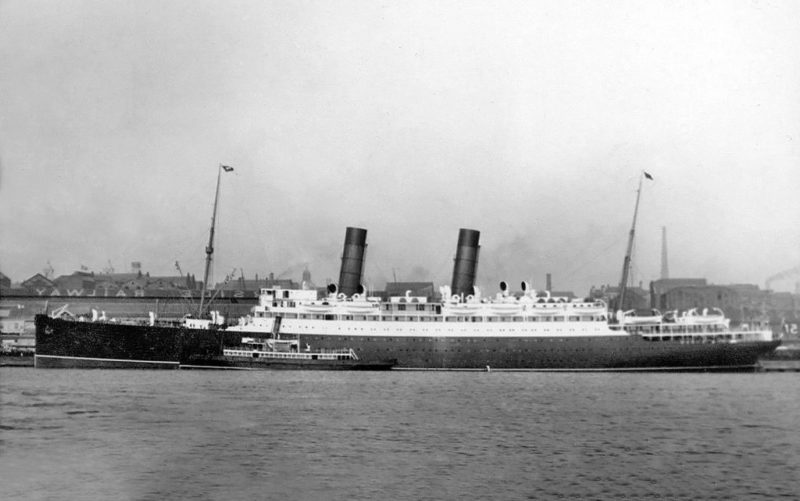
They were handsome twin funnelled vessels, able to carry 2,850 passengers in three classes.
Laconia was launched on the 27th July 1911 by the wife of the US Ambassador, Mrs Whitelaw Reid. The ship was delivered on the 12th December 1911, her maiden voyage commenced on 20th January 1912.
Franconia was taken into service as a troop transport early in 1915. On the 4th October 1916 she was torpedoed by the German U-boat UB-47, under the command of Kaptit. Walfgang Steinbauer, 195 miles east of Malta. There were no troops onboard and 12 crewmembers lost their lives with others being rescued by the hospital ship Dover Castle. UB-47 survived the war being surrendered at Venice on the 6th November 1918 and was scrapped the following year.
On the 27th October 1914 Laconia was hired as an Armed Merchant Cruiser and fitted with eight 6-inch guns, being commissioned as HMS Laconia on the 24th November 1914 at Liverpool.
The ship departed from Portsmouth on the 16th December 1914 carrying 3 Short Folder Type aircraft, destined for Durban. Laconia was based at Simonstown and operated off East Africa until April 1915 when she was used as a Headquarters ship for the operations to capture Tanga and the colony of German East Africa. She resumed patrol duties in September 1915 until replaced by the former P & O Liner Himalaya (6,898grt/1892) that had also been commissioned as an Armed Merchant Cruiser.
In June 1916 Laconia returned to the UK in a convoy carrying a large shipment of gold from Cape Town, before paying off at Devonport on the 2nd August 1916. She resumed Cunard’s North Atlantic Service on the 9th September.
On the 25th February 1917 the liner was en-route from the United States to Britain when she was torpedoed in the late evening by the German U-boat U-50, under the command of Kaptit. Gerhard Berger, six nautical miles north west of Fastnet.
Captain William Robert Duncan Irvine was master of the liner which was carrying $1million in securities from J.P. Morgan, 852 bars of silver, 132 boxes of silver coins, 5,400 sacks of mail, 4.5 million lbs. of empty shell cases, 3,000 tons of steel and 2,843 bales of cotton. Also onboard were 75 passengers and a crew of 217. The first torpedo struck on the starboard side just aft of the engine room. Twenty minutes later, as the ship was still afloat, a second torpedo struck the starboard side exploding in the engine room.

Laconia sank at 10.20pm, with a total of 12 people being killed, six crewmembers and six passengers. Those lost included two American citizens, Mrs Mary Hoy and her daughter Elizabeth Hoy from Chicago.
A reporter from the Chicago Tribune, Floyd Gibbons, was also a passenger on the ship and provided a graphic account of the loss of this fine vessel. His report in the newspaper was read to both Houses of Congress and went some way to helping push the USA in to joining the War on the side of the Allies.
German U-boat U-50 was of the U-43 Class, launched on the 31st December 1915 and completed in early 1916. She displaced 940 tons submerged and carried two bow and 2 stern 20 inch torpedo tubes and carried a crew of 35. U-50 was probably mined and sunk in the North Sea off Terschelling on or after the 31st August 1917.
The second liner Laconia, completed in 1922, was one of the five Scythia Class, Cunard 20,000 tonners completed after the First World War. They were Scythia, Samaria, Laconia, Franconia and Carinthia. Franconia and Laconia commemorating the names of their predecessors lost in 1916 and 1917 respectively.
Laconia had a gross tonnage of 19,680, a length of 623 feet a beam of 73 feet 7 inches and a draught of 40 feet 6 inches. Like her predecessor she was built by Swan, Hunter and Wigham Richardson on the Tyne (Yard No 1125) with engines by the Wallsend Slipway. Six steam turbines double reduction geared to two shafts produced 13,600 shp for a speed of about 16 knots. She could carry 350 first class, 350 second class and 1,500 third class passengers.
Laconia was launched on the 9th April 1921 and left the builders yard on the 21st April 1922 with her maiden voyage from Southampton to New York on the 25th May 1922. Subsequently she operated on the Liverpool to New York or Boston service with occasional trips on the Hamburg-Southampton-New York route.
Laconia was the first ship to undertake a ‘world cruise’ when she was exclusively chartered by the American Express Company leaving New York on the 21st November 1922 and arriving back on the 30th March 1923 after calling at 22 ports. She undertook regular cruising schedules in the 1930s during the ‘down season’. These cruises were mainly to the Mediterranean when the ship was painted white with green boot topping.
On the 5th September 1939 Laconia was hired as an Armed Merchant Cruiser and fitted with eight 6-inch guns and two 3 inch anti aircraft guns. Operating in the Atlantic, she ran aground in the Bedford Basin at Halifax on the 9th June 1940. Her damage was so severe she was not returned to service until the end of July of that year.
On the 25th September 1941 Laconia paid off at Birkenhead and was converted to a troopship. Cammell Laird completed the work early in 1942 and the vessel began trooping voyages to the Middle East.
In August 1942 Laconia was at Suez and was due to sail back to the UK via the Cape of Good Hope.
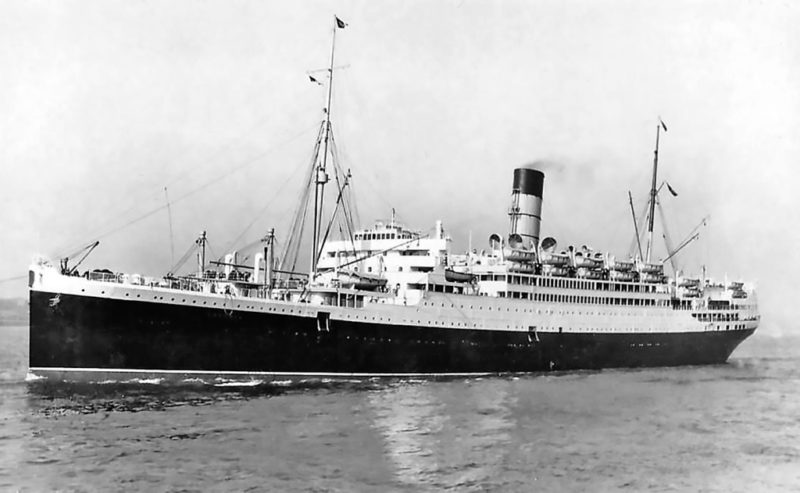
Laconia was armed with two 4.7 – inch guns (of First World War vintage and made in Japan) six 3-inch A.A. guns, six 1.5-inch A.A. guns, four quick firing Bofors guns, two groups of 2 inch rockets, two box kites to be fitted to the mainmast which could be elevated to 250 feet with bombs attached to a wire and two mine cutting paravane.
Laconia sailed on the 12th August 1942 from Port Tewfik (now Suez Port) situated at the southern boundary of the Suez Canal. The vessel was making her way back to the UK via the Cape of Good Hope. Her captain was Captain Rudolph Sharp CBE, RD, RNR. He had been in command of the Cunard liner Lancastria when she had been bombed and sunk with heavy loss of life whilst evacuating troops off St. Nazaire on the 17th June 1940.
Calls were made at Aden, Mombasa, Durban and Cape Town where she arrived on the 1st September 1942.
When Laconia departed from Cape Town she had on board 463 officers and crew, 286 passengers from the three armed services, 1,793 Italian prisoners of war 103 Polish guards and 87 civilians (including women and children). A total of 2,732 persons.
At about 10am on Saturday 12th September 1942 a lookout on the German U-boat U-156 under the command of Korvettenkapitan Werner Hartenstein spotted smoke on the horizon and the vessel appeared to be following a zig-zag course of 17 knots. Steaming at 16 knots on the surface in a straight course towards the ship it took until 10pm that evening for the submarine to catch up.
At 10.07pm U-156 launched two torpedoes, whilst on the surface, from tubes 1 and 3 hitting Laconia on the starboard side at No. 4 hold containing 450 Italian prisoners, many of whom were killed instantly. The second torpedo hit No. 2 hold also filled with Italians.
The ship immediately took a heavy list to starboard, with many lifeboats smashed due to the explosions. Lifeboats on the port side were unable to be launched until the ship settled due to the heavy list to starboard and many onboard simply jumped into the shark-infested waters.
At 11.23pm Laconia slid beneath the waves and U-156 sailed slowly towards where the survivors were in the water and in the boats and life rafts. Through the cries of the survivors it was apparent that the voices came from women, children, Poles and Italians! This had put a different perspective on the situation and the U-boat began to pick up survivors without differentiating between the various nationalities.
Assistance was requested as U-156 was now packed with 263 survivors as well as seeing to the needs of those in nearby lifeboats some of which were taken in tow. Two more U-boats, U-506 (Kapitanleutnant Eric Wurdemann) and U-507 Korvettenkap-itan Harro Schact were ordered to the scene, both arriving late morning and early afternoon on the 15th September. U-506 took 132 Italians on board and U-507 found four lifeboats in the general area. These contained a total of 153 persons, 149 Italians and four British, including two women.
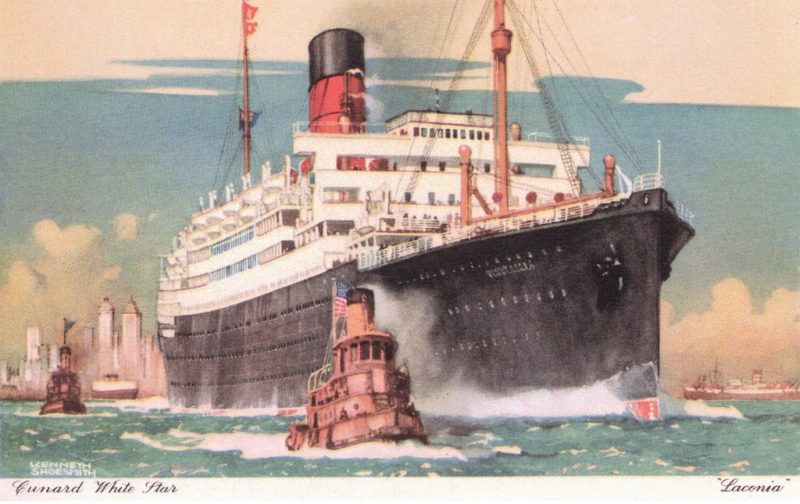
With many survivors onboard as well as towing lifeboats the three U-boats began to make their way independently towards the west coast of Africa searching for more survivors en-route.
On the 16th September the Italian submarine Commandante Cappellini under the command of Lieutenant Commander Marco Revedin also arrived in the area.
Commandante Cappellini discovered two lifeboats from Laconia containing 50 and 84 occupants respectively all of which were British. These were supplied with food and water. Two waterlogged lifeboats were then found containing British and Polish personnel who were transferred to undamaged boats, apart from two British senior officers who were taken prisoner. Forty-eight Italians, two of whom died the following day were also taken onboard.
Via diplomatic channels assistance was requested from the Vichy French authorities to aid with the rescue. This was agreed, if the Germans agreed to replace the fuel used. This was subsequently provided.
The cruiser Gloire, and sloops Annamite and Dumont-d’Urville were despatched from Dakar, Conaky in French Guinea and Cotonou in Benin respectively.
However, at 11.25am on the 16th September a lookout on U-156 reported an aircraft approaching. The submarine placed a large white flag with a red cross on it to cover the deck gun, plus the submarine was towing a number of lifeboats. One of the survivors, an RAF officer, was given permission to pass a message by signal lamp to the aircraft outlining the situation and not to attack. The aircraft flew away but returned at 12.32pm.
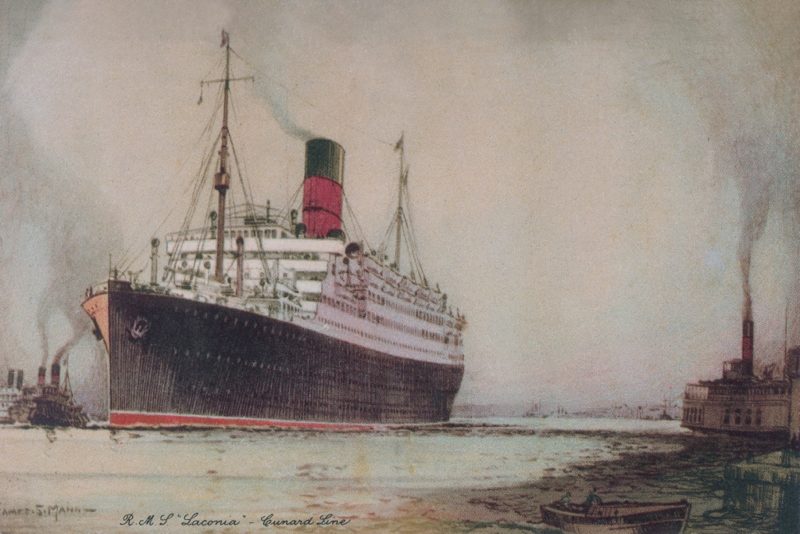
The aircraft, a US B24 four-engined Liberator from Ascension Island was piloted by Lt. J.D. Harden USAAF and after his first flight over U-156, he requested instructions from his base on Ascension Island. The Army Captain in charge, Captain Robert C. Richardson III gave the order to sink the submarine.

On the second run bombs and depth charges were dropped. These killed dozens of survivors, sinking one and overturning another lifeboat. All the survivors, apart from the Italians, on board U-156 were ordered either into the water or if possible into the remaining lifeboats. The U-boat herself was also damaged in the attack and Hartenstein ordered the submarine to submerge and sailed away taking no further part in the operation.
On the 17th September a twin engine B25 Mitchell bomber from Ascension Island sighted U-506 and approached the U-boat, which crash dived. At the time it contained 151 survivors including women and children. The bomber made a second run, and dropped two bombs and two depth charges, fortunately not causing any damage.
Eventually the sloop Annamite and cruiser Gloire picked up survivors from the scattered lifeboats as well as transferring the survivors from U-506 and U-507 on the 17th September. At 10am on the 18th September Annamite transferred 315 survivors to Gloire.
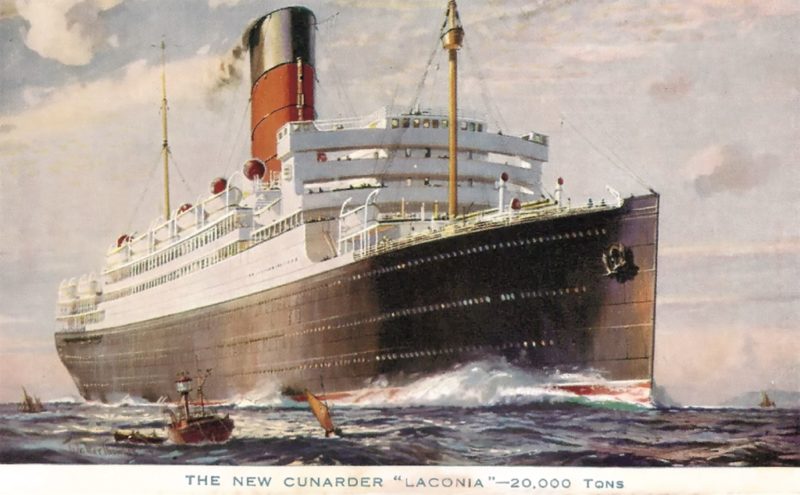
The sloop Dumont-d’Urville, being much slower than the other French vessels, did not reach the rendezvous position, but instead was instructed to meet with Commandante Cappellini and take onboard her survivors. The submarine kept six Italian nationals and two British Officers, transferring 42 Italians. This transfer took place on the morning of the 20th September.
Whilst en-route to the rendezvous the French vessel came across survivors from the British motor vessel Trevilley. This ship, owned by Hain-Nourse, had been completed in 1940 by Lithgow and Co. at Port Glasgow. She was 5,296 gross tons and had been torpedoed and sunk by gunfire from the German U-boat U-68 on the 12th September at position 4°30′ south and 7°50′ west.
U-68 was sunk on the 10th April 1944 by aircraft from the US escort carrier USS Guadalcanal north of Madeira.
The rescued personnel onboard the French ships were taken to Dakar, and then on to Casablanca where they were put into an internment camp in French North Africa. Most were quickly liberated following the Allied invasion of North Africa in 1942.
One of the lifeboats containing survivors was at sea for 27 days before eventually making landfall in Liberia. During the course of the journey 53 out of 69 survivors died.
Out of 2,732 onboard, of those who survived, 1,039 were taken onboard Gloire, 42 by Dumont-d’Urville, 4 British Officers were taken prisoner (2 in U-507 and 2 in Cappellini) 6 Italians remained in Cappellini and 20 saved in the last two lifeboats, several of whom died almost immediately after landing. A total of 1,111. Out of 1,793 Italians onboard, 450 survived, and 73 out of 103 Polish guards were saved. Annamite, which was only 900 tons in displacement, transferred her survivors to Gloire.
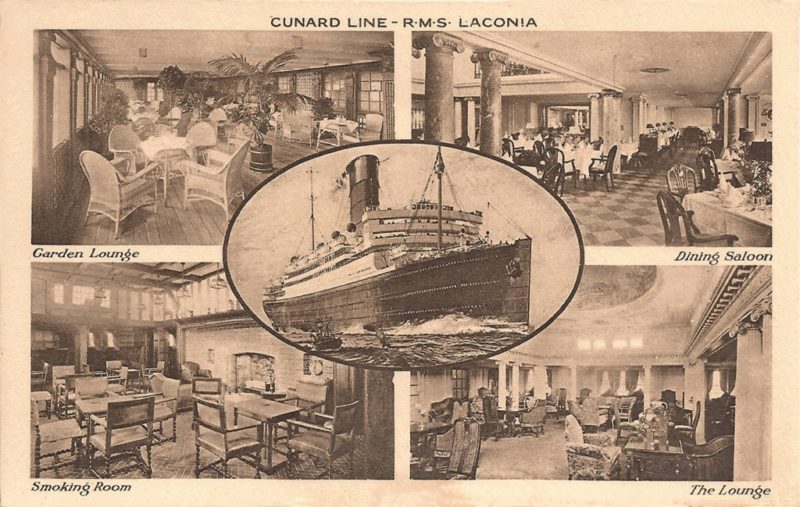
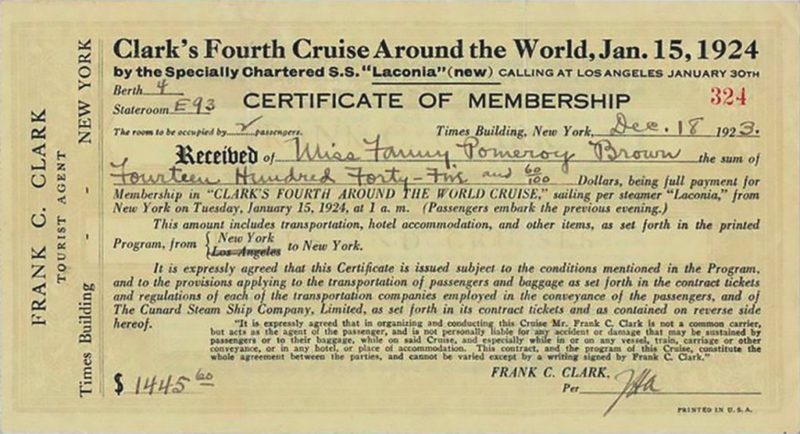
Up to the loss of Laconia, German U-boats had generally complied with the rules of the Geneva Convention of 1907, in that assistance should be offered to the shipwrecked sailors of steamers sunk without warning, as long as the boat would not be endangered or the military mission prejudiced.
On the 27th August 1942 the Clan Macwhirter (5,941 grt/1918) a straggler from convoy SL119 was torpedoed by U-156 about 190 miles north north west of Madeira. The vessel under the command of Captain Roderick Sutherland Masters, which was owned by the Clan Line (Cayzer Irvine) sank stern first after two torpedoes struck.
U-156 surfaced, giving those in the lifeboats assistance and set them the course and distance to Madeira. The survivors were picked up by the Portuguese sloop, Pedro Nunes, and landed at Funchal on the 2nd September 1942.
As a result of the sinking of the Laconia, Admiral Donitz issued an order, known as “The Laconia Order” which, in summary, stated that no attempt must be made to rescue crews of ships sunk, including those in the water. Exceptions applied to the rescue of persons who may be useful for intelligence purposes. Nor should food or water be provided. U boat commanders should be harsh, bearing in mind that the enemy takes no regard of women and children in his bombing attacks on German cities.
At the Nuremburg War Trials in 1946 evidence was given of “The Laconia Order”. However the defence argued that a similar policy was also in force by the USA in the Pacific. Donitz was found guilty of Crimes Against Peace and War Crimes. He was sentenced to 10 years in prison.
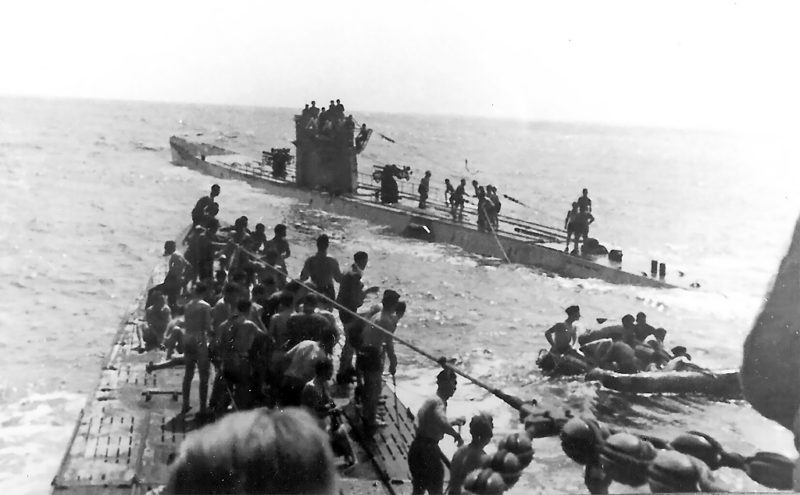
The ships involved
U-156, U-506, U-507 were all Type IXC U-boats. Displacing 1,232 tons (submerged) carrying six 21 inch Torpedo Tubes (up to 25 Torpedoes), one 4.1 inch gun, one 37 mm A.A. gun and one 20 mm A.A. gun.
They carried a crew of between 48 and 54 and had a range of 11,000 miles at 12 knots on the surface and 63 miles at 4 knots submerged. Their maximum speed was 18.25 knots on the surface and 7.25 knots submerged.
U-156 was built by AG Weser at Bremen and launched on the 21st May 1941, commencing her first 18 day patrol from Kiel on the 24th December 1941. Werner Hartenstein had been Captain since her commissioning and had been promoted from Kapitanleutnant to Korvettenkapitan for the patrol, which involved the sinking of Laconia.
This patrol had commenced on the 20th August 1942 when U-156 left Lorient in France returning 89 days later on the 16th November 1942.
During this patrol U-156 sank three ships, Clan Macwhirter on the 27th August, Laconia on the 12th September and Quebec City (4,745 grt/1927) on the 19th September. Sir Wm. Reardon Smith and Sons Ltd. owned this freighter.
U-156 was lost on the 8th March 1943 in mid Atlantic east of Barbados when depth charged by a Catalina aircraft of the US Navy. There were no survivors from the crew of 53.

U-506 and U-507 were both built by Deutsche Werft, Hamburg. U-506 was launched on the 20th June 1941 and U-507 on the 15th July 1941.
U-506 was lost on the 12th July 1943 in the North Atlantic west of Vigo when she was depth charged by a Liberator aircraft from the US Air Force. 48 crewmembers were killed and 6 rescued. The submarine had left Lorient on the 16th January 1943 under the command of Kapitanleutnant E. Wurdemann.
U-507 was lost on the 13th January 1943 in the South Atlantic north west of Fortaleza by depth charges dropped by a Catalina aircraft of the US Navy. All 54 crewmembers were killed. She had left Lorient on the 28th November 1942 under the command of Korvettenkapitan H. Schacht.
Italian Submarine Commandante Cappellini was built by Odero-Terni-Orlando Mugglana, La Spezia and completed in September 1939. She had a displacement of 1,315 tons (submerged) and carried eight 21 inch Torpedo Tubes (sixteen torpedoes), two 3.9 inch guns and four 13.2mm A.A. guns. On the surface the boat had a maximum speed of 18 knots and a submerged speed of 8.2 knots. She carried a crew of 58. Her commanding officer was Lt. Commander Marco Revedin.
The vessel was captured by the Japanese at Sabang on the 10th September 1943 after the Italian surrender. The boat was then transferred to the German Navy becoming UIT-24, operating in the Pacific.
The vessel was again taken over by the Japanese following the surrender of Germany and renumbered I-503 and converted to a transport submarine.
On the 2nd September 1945 the submarine was found at Kobe by US forces and subsequently sunk by the US Navy on 16th April 1946 in the Kii Suido between the Japanese islands of Honshu and Shikolu.
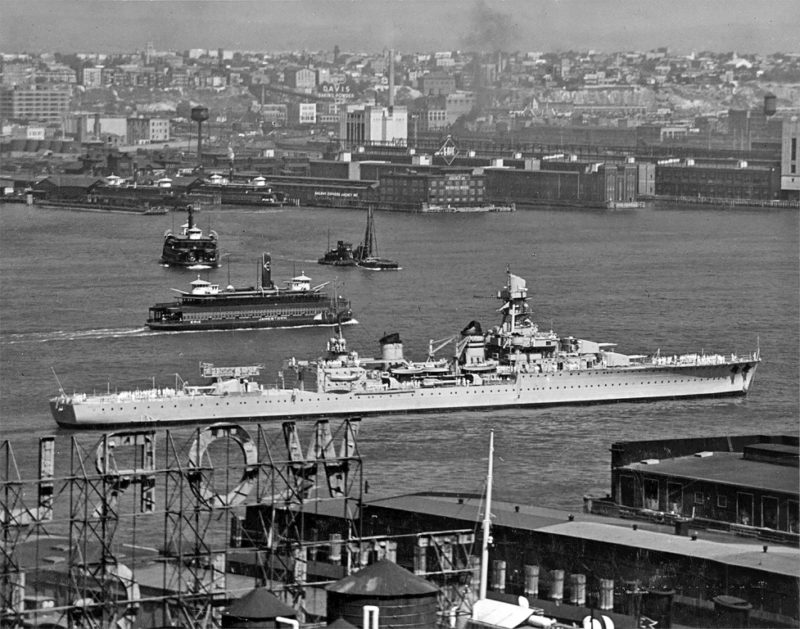
French cruiser Gloire was launched on the 28th September 1935 and completed at Bordeaux on the 15th November 1937. The vessel displaced 9,100 tons (full load) and carried nine 6-inch guns in the triple turrets, plus lighter A.A. guns. She carried a crew of about 540. Her commanding officer was Commander Graziani. Gloire served with the French Navy following the war and was scrapped in January 1958.
French Sloop Annamite was launched on the 17th June 1939 at Lorient. She displaced 900 tons (full load) and carried two 3.9 inch guns and smaller A.A. guns. She carried a crew of about 100 and had a maximum speed of 20 knots. Her commanding officer was Lt. Commander Quemard. She was renamed Chamois in 1953 and transferred to Morocco in 1961 becoming El Lahiq. Eventually her hull was used as a breakwater at Ile de Levant in 1967.
Dumont-d’Urville was a French Colonial Sloop and launched at Bordeaux on the 21st March 1931. She displaced 2,600 tons (full load) and carried three 5.5 inch guns plus smaller A.A. guns and a capacity to carry up to 50 mines. The vessel carried a crew of 170 and had a maximum speed of 15.5 knots.
Her commanding officer was Commander François Madelin. The sloop was withdrawn from service and scrapped in March 1958.
The loss of both ships named Laconia had a big impact in history, the first by bringing the USA into the First World War, and the second causing diplomatic chaos and evidence to convict at the Nuremburg War Crimes Trials in 1946.
Although Cunard had a further vessel named Franconia, the former Ivernia of 1955 was renamed Franconia in 1963 before being sold in 1973, the name Laconia was never used again.
However, the Greek Line acquired the passenger vessel Johan van Oldenbarnevelt (19,040 grt/1930) from the Nederland Line in March 1963 and renamed her Lakonia.
On the 22nd December 1963 whilst on a Christmas Cruise to the Canary Islands, departing from Southampton on the 19th December 1963 the vessel caught fire off North Africa. A total of 128 persons died in the disaster, and the vessel eventually sank on the 29th December 1963, 250 nautical miles west of Gibraltar.
Was this a case of another unlucky Laconia/Lakonia?
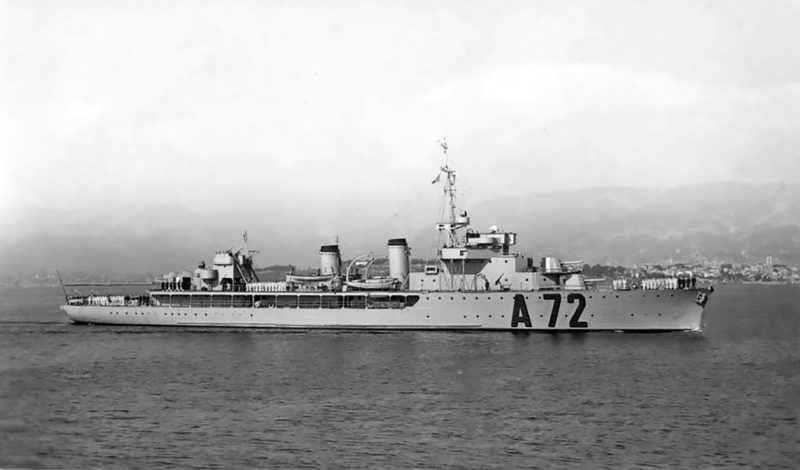

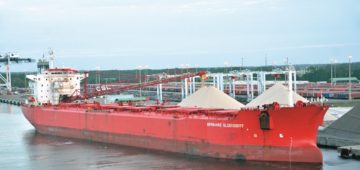



Comments
Sorry, comments are closed for this item